Mon 14 Feb 2011
A TV Series Review by Curt Evans: MONK (Seasons 1-4).
Posted by Steve under Reviews , TV mysteries[18] Comments

MONK. USA Cable Network. Seasons 1-4: 2002-2006. Tony Shalhoub (Adrian Monk), Jason Gray-Stanford (Lt. Randall Disher), Ted Levine (Captain Leland Stottlemeyer), Traylor Howard (Natalie Teeger), Stanley Kamel (Dr. Charles Kroger), Bitty Schram (Sharona Fleming).
As an extremely devoted admirer of Golden Age mystery fiction — just read last week’s Lee Thayer review! — I perhaps have a tendency to not give credit where credit is due to more modern work.
Yet I will freely admit that my favorite American television mystery series is one of recent vintage: the magnificent Monk, which ran from 2002 to 2009. My nephew John Hendricks prevailed upon me to watch this series, and I am glad that he did.
In Monk, the eccentric Great Detective of grand, old tradition is alive and well (well, perhaps not entirely well). As brilliantly created by three-time Emmy award winner Tony Shalhoub, consulting detective Adrian Monk, traumatized by the murder of his wife, Trudy, is a teeming mass of compulsions and phobias, yet he is also utterly brilliant and indispensable to the San Francisco police, who, in classical tradition, clearly would not have a prayer of solving one of their sixteen yearly murder cases without him.
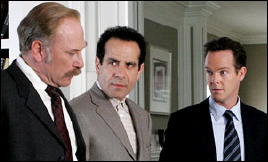
Representing the San Francisco police force in each episode are the imposing but perhaps not overly percipient Captain Leland Stottlemeyer (Ted Levine, otherwise most familar to me from his creepy performances in the genre films The Silence of the Lambs and Shutter Island) and his bumbling, overgrown boy scout assistant, Lieutenant Randy Disher (as broadly though amusingly played by Jason Gray-Stanford, he seems to have graduated from a police college surely located somewhere on Gilligan’s Island).
Completing this band is Monk’s personal assistant (and essential caretaker), the brassy and sometimes abrasive former nurse Sharona Fleming (Bitty Schram), who is later replaced midway through season three by the rather sweeter-natured (I think she has the patience of a saint) Natalie Teeger (Traylor Howard).
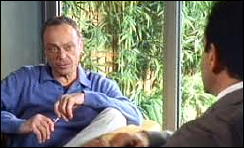
Appearing more occasionally is Monk’s psychiatrist (I think he has the patience of a saint), Dr. Charles Kroger (Stanley Kamel). Dr. Kroger’s therapy sessions with Monk are themselves often mini-masterpieces of humor (Kamel sadly died after season six, but thankfully he appeared in nearly half the Monk episodes filmed during his life).
Season one of Monk has some inspired episodes (I particularly liked one that played a brilliant variation on G. K. Chesterton’s “The Invisible Man”), but also some clunkers. The series seems to have had a smaller budget (it looks more studio bound) in the first season and characters who had not quite gelled, as is common in debut seasons of series.
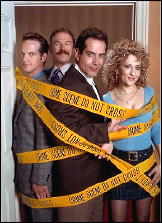
Season two, on the other hand, seems to me nearly flawless. The ingenuity of the mystery plots often is quite remarkable, in my view, for forty-five minute television shows.
Some highlights from various episodes include: perfect alibis (“Mr. Monk Goes Back to School” and “Mr Monk and the TV Star”); a locked exercise room murder (“Mr. Monk Meets the Playboy”); a bizarre case of a parachutist drowning in mid-air (“Mr. Monk Goes to Mexico” — this is not quite fair play but still very clever and wonderfully outre); a murder committed by a man in a coma (“Mr. Monk and the Sleeping Suspect”); and the classic situation of the murder committed during the performance of a play (“Mr. Monk Goes to the Theater” — this crams novel length complexity into a small space).
With their impossible situations and miracle problems, many of these episodes successfully invoke the brilliance of the Golden Age of the detective novel, as penned by such past masters as John Dickson Carr, Freeman Wills Crofts and John Rhode.
There is also an episode, “Mr. Monk and the Three Pies,” that was surely intended as an homage to Arthur Conan Doyle’s Sherlock Holmes. Clearly modeled on Jacques Barzun’s favorite Holmes story, “The Adventure of the Six Napoleons,” “Pies” also introduces a brother for Adrian Monk (the gifted Oscar-nominated actor John Turturro), who in turn is obviously influenced by Sherlock’s brother, Mycroft (he’s not fat, but he’s even smarter than Adrian and, more phobic as well, he’s essentially immobile, never leaving his house).
Often in addition to being clever, the series is extremely funny. Mr. Monk confronting a rather less than five-star motel in Mexico should have you in stitches, as should his being forced to sham marriage with Sharona (in “Mr. Monk Gets Married,” which involves another classic Golden Age plot, the treasure hunt).
Season three strikes me as not quite up to the sheer perfection of season two. There was a particular plot structure that, while clever, became overused in this season and there seemed, in the middle of it, to be evident problems with the actress playing Sharona. (She was entirely written out of one episode and apparently was either fired or quit.)
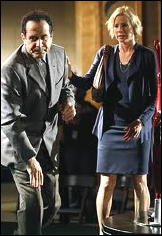
After Sharona was abruptly and completely written out of the series, a replacement for her, the chipper Natalie, had to be written in, and her relationship with Monk did not really gel until season four.
Another problem from my perspective is that the series started to indulge a bit much in the psychodrama of Monk’s obsession with his dead wife, Trudy (she even starts to appear to him in physical manifestations). A true Golden Age traditionalist likes the writer to stick a bit more to the plot!
However, there are some excellent episodes in season three, including one of the very best in the series, “Mr. Monk Gets Cabin Fever,” which takes a remarkably original and delightful approach to the classical “drawing room lecture” (where the Great Detective reveals all to the assembled suspects).
Also compelling are “Mr. Monk Gets Stuck in Traffic,” a clever inverted mystery (where we know who committed the murder) unfolding entirely within a highway traffic jam, and “Mr. Monk Goes to Vegas,” which revolves around the strangling murder of an unwanted wife while she was alone in an elevator (this one is reminiscent of a classic John Dickson Carr-John Rhode novel).
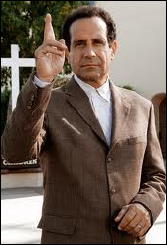
Season four nearly maintains the level of season two, with a raft of clever episodes: Monk confronting a rival detective who somehow is smarter than he his (“Mr. Monk and the Other Detective”); Monk reuniting with his brother to confront a really baffling murder problem (“Mr. Monk Goes Home Again”); a case involving the teasing question of why someone would break a stock analyst’s right hand (“Mr. Monk Goes to the Office”).
More from season four: A variation on the Paris Exposition “Lady Vanishes” problem (“Mr. Monk Gets Drunk”); a variation on Alfred Hitchcock’s film Vertigo (“Mr. and Mrs. Monk”); a variation — okay, seemingly total theft from — Anthony Berkeley’s classic poisoning short story, “The Avenging Chance” (“Mr. Monk and the Secret Santa”); a comedic variation on the amnesia plot (“Mr. Monk Bumps his Head”); another perfect alibi case (“Mr. Monk and the Astronaut”) and Mr. Monk solving a present-time murder while serving on a jury (“Mr. Monk Gets Jury Duty”).
Once again, some of the episodes are extremely funny, especially “Mr. Monk Goes to the Dentist,” with it hilarious parody of the Laurence Olivier-Dustin Hoffman “Is It Safe?” scene from the film Marathon Man. Some are funny and poignant, like “Mr. Monk Goes to the Office,” because we realize that behind the humor of Monk’s eccentricities are really mental disorders that set him apart from humanity and make him a very lonely man. As Monk regularly pronounces, his genius truly is “a blessing — and a curse.”
Simultaneously successfully portraying the amazing deductive genius of the classical Great Detective and making us see as well his human side in the modern manner makes Monk a pure blessing.
February 15th, 2011 at 12:00 am
Despite some clunkers there were many great episodes of this series for Golden Age fans. I think my personal favorite had possibly the worlds best alibi — the killer was an astronaut in space when the crime happened.
Of course Adrian’s problems grew a bit more cartoonish as the series progressed, and anyone forced to overcome his phobia’s as often as Adrian would likely have recovered by now — but in a series like this you have to give it the internal logic of the storyline and not impose the real world on it — much as we do with Ellery Queen, Agatha Christie, and John Dickson Carr.
I was impressed by this series. It maintained a fairly high level for most of its run, and it stayed true to the character even a few times when it might have been easier not to.
February 15th, 2011 at 1:03 am
Wondering what you think of Lee Goldberg’s successful paperback tie-in books based on MONK.
February 15th, 2011 at 1:11 am
I’m going to have to reassess my general avoidance of this series. I’ve seen only a small handful of episodes, and for the most part, they only reinforced what I’d heard about the show, that they mostly played it for laughs.
Humor, as has been said many times over on this blog, is a very personal thing. The show Curt calls hilarious, “Mr. Monk Goes to the Dentist,” I thought was excruciatingly bad. Overdone and done again. I finally had to turn it off.
I also watched “Mr. Monk Buys a House,” the first episode of the seventh season, in which a gang of contractors hired to refurbish the house tear it down instead, shred by shred, looking for hidden loot, as I recall. Not funny to me, and it was the last show I watched that season.
But I did watch the one with astronaut, which was terrific, as both Curt and David have pointed out.
So for me, a mixed bag. I sure wish a certain pair of San Francisco cops knew how to walk out of a room with the door open, but they don’t.
But I never saw any of the shows with Sharona in them, and that’s where maybe I’ve messed up. I’d better go back to the first season, it looks like, and give the series another try.
February 15th, 2011 at 1:21 am
Michael
You sneaked your comment in before I’d finished typing mine. I’ve only browsed through a few of the novelizations I’ve purchased, and not surprisingly, based only on this limited observation, Lee Goldberg nails the characters to a tee.
I say “not surprisingly” since Lee has written for the series, two episodes perhaps, and maybe three.
February 15th, 2011 at 3:04 am
Another good episode with Monk’s brother dealt with why someone was stealing a certain kind of candy bar on Halloween. It not only gave insight into the two damaged brothers, but was a pretty good mystery too.
That said, there were often too many not terribly funny episodes more about the quirks than the mystery and perhaps too many of what I call ‘mythos’ episodes (those that deal with the central myth of the series — in this case the murder of Monk’s wife). Those tended to be contradictory and confusing to the point that towards the end you half expected to discover his wife Trudi had faked her death just to get away from him.
The best episodes found a balance between the humor and mystery elements, and posited some clever mysteries that no one but a Monk could have solved.
February 15th, 2011 at 6:36 am
My experience with MONK is similar to Steve’s but I watched several episodes in the first season before giving up. At first I found some humor in the series but then after several incidents with the germ phobia subject, I moved on to other TV shows that did not annoy me.
Also US series often run for too many seasons if they are a rating success. For instance HOUSE was of interest but then after awhile I got tired of his grouchy moods and stopped watching the show.
February 15th, 2011 at 1:30 pm
I’m not a big fan of the apparitional Trudy, or the knock-offs of “The Fugitive,” where Monk is tracking “the Six-Fingered Man.”
I’ve noticed in Season Five that the episodes are more centered around “bits” (Monk suffers through a sanitation strike; Monk temporarily loses his eyesight) than a strong mystery. If you like the dynamic and the characters of the show by that time, you still enjoy it; but I would recommend the earlier episodes, especially season two. They certainly have some of the best mystery plotting I’ve seen on television and they usually are fair play.
I thought Monk’s behavior in the dentist’s torture chair was hilarious, but I do agree sometimes the humor bits don’t work (Monk not being able to write on the school blackboard, because every letter had to be perfectly even, was more excruciating than excruciatingly funny).
Randy is the Ted Knight of police detectives. You have to wonder how he keeps his job (maybe Stottlemeyer figures Randy makes him look good by comparison?).
February 15th, 2011 at 1:32 pm
Oh, I’ve seen the Monk books but have never read them. How many are there (I think three when I checked last)?
February 15th, 2011 at 1:46 pm
Quite a few more than three, Curt. Other than the Jessica Fletcher books, it is, as Michael said in Comment #2, one of the more successful tie-in series. Mystery-wise, that is, otherwise STAR TREK wins, hands down.
1. Mr. Monk Goes to the Fire House (2006)
2. Mr. Monk Goes to Hawaii (2006)
3. Mr. Monk and The Blue Flu (2007)
4. Mr. Monk and the Two Assistants (2007)
5. Mr. Monk in Outer Space (2007)
6. Mr. Monk Goes to Germany (2008)
7. Mr. Monk Is Miserable (2008)
8. Mr. Monk and the Dirty Cop (2009)
9. Mr. Monk in Trouble (2009)
10. Mr. Monk is Cleaned Out (2010)
11. Mr. Monk on the Road (2011)
12. Mr. Monk on the Couch (2011)
February 15th, 2011 at 1:57 pm
What makes any TV series last, both in first run and then in rerun afterlife, is the people onscreen.
MONK has to have been the best cast series of its type, because its actors knew just how far to go with potetntially risible characters.
The unsung hero of MONK, in my view, is Ted Levine as Stottlemyer. The easy way would have been to make him Gale Gordon with a badge, but Levine was pitch-perfect in restrained exasperation. My favorite line is one of his, from the three pies episode:
“Keep your hands away from that pie … and please don’t make me say that again.”
That said, I don’t wish to slight any of the other regular or semi-regular actors here, from Tony Shalhoub on out. The absence of ham was a welcome relief from what passes nowadays for comedy on TV.
Of course, some episodes were better written/plotted/staged than others; that’s par for the course in episodic TV. MONK’s batting average is higher than most, and that gets it into the pantheon.
Lee Goldberg’s novels (which now number nine and counting) keep up the high score.
February 15th, 2011 at 2:12 pm
I’ve always enjoyed the show, but the scheduling on mainstream British TV has been bizarre in the extreme. It’s often been put on the minority BBC 2 channel on Saturday or Sunday mornings, making it the sort of show that you have to actively pursue in order to see. Still hoping that someone will just start showing all of the episodes in order, as I’d love to see them all.
February 15th, 2011 at 9:50 pm
Hadn’t realized there were all those books!
Another locked room episode I should have mentioned was the one with the seeming killer monkey, but that was a bit of a cheat, in classical terms.
February 16th, 2011 at 1:40 am
Oh, one other thing, agree about Levine, he’s a very good actor. And his character is smarter than Randy (though so is the aforementioned monkey).
February 16th, 2011 at 2:16 am
I always assume Randy’s job is much the same as Watson’s in the Holmes stories — a character stupider than any reader or viewer could possibly be, and therefore saving us the embarassment that if we didn’t outwit Monk, at least we are always one step ahead of Randy.
Oh, and they do establish why Randy is tolerated by his boss in a couple of episodes where they imply that Captain Stottlemeyer has trouble working with almost anyone else in the job. Sort of a co-dependency thing.
Levine is very good, and his relationship with Monk grows over the course of the series into one of the small screens more interesting friendships — though I have to admit at first it took me a little adjustment from his role in SILENCE OF THE LAMBS.
Whatever else, this is one of the most consistently well acted series on the air. Shaloub earned everyone of those Emmys.
February 16th, 2011 at 3:15 am
Randy’s “character arc” kind of reminds of that of Nigel Bruce’s Watson in the films. Guess he’s the Gen X Nigel Bruce.
I find a lot of people know Levine only from Monk and are floored to find out he was that other serial killer in Silence of the Lambs–you know, the really creepy one! 😉
February 17th, 2011 at 3:11 am
Thank you for all your kind words about my MONK books.
Steve,
I’ve co-written three episodes of the MONK TV series with William Rabkin — “Mr. Monk Goes to Mexico,” “Mr. Monk and The Godfather,” and “Mr. Monk Can’t See a Thing,” which was based on my book MR. MONK GOES TO THE FIRE HOUSE. Another MONK episode, “Mr. Monk and the Badge,” which I didn’t write, was based on my book MR. MONK AND THE BLUE FLU.
Michael,
The MONK books began as paperback originals but since book #4, MR. MONK AND THE TWO ASSISTANTS, they have been coming out in hardcover first.
Mike,
There have been 12 MONK books…and I am now in the midst of writing my 13th, MR. MONK ON PATROL. There will be at least two more after that before the end of 2012.
Excerpts of the MONK books have often appeared as short stories in Ellery Queen Mystery Magazine. In fact, “Mr. Monk and the Paperboy,” an excerpt from MR. MONK ON THE COUCH, will be appearing in the June issue.
Lee
February 17th, 2011 at 12:03 pm
To Lee Goldberg(in self-defense):
When I wrote my comment I was counting off the books on my shelf in my memory.
Thing is, I was counting the hardcovers, because that’s how I’ve been buying them since they started coming out that way. I’d forgotten about the three paperbacks that came before (which of course I have).
Anyway, it’s good to know that the books will contiue to at least 14.
Also that the series was left at least a little open-ended, for the possibility of a movie-length sequel or two.
(You know, I always thought that the business of how Natalie’s late husband met his end in combat was going to be a subject of an episode before the series ended its run. Maybe that could be a MONK movie …)
February 17th, 2011 at 3:44 pm
I dealt a bit with the death of Natalie’s husband in MR. MONK GOES TO HAWAII.
My book MR. MONK ON THE ROAD, which is out now, is the first book set after the final episode of the TV series…and incorporates all the “changes” made to the franchise. And I’ve expanded on them with some of my own, with MONK creator Andy Breckman’s blessing, of course.
Lee